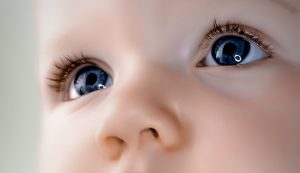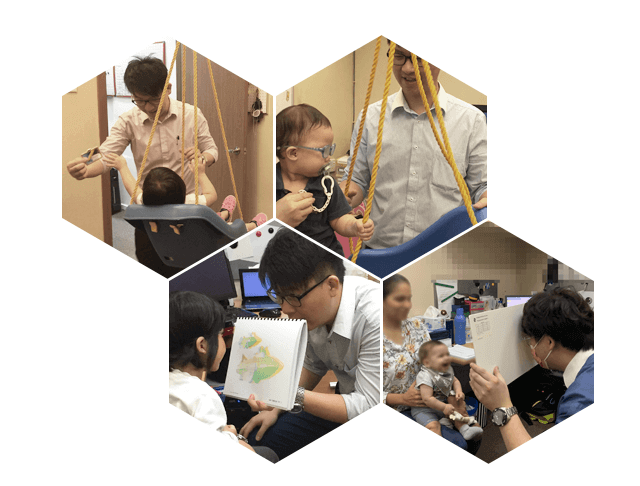Services
GUIDE FOR PARENTS: MONITORING CHILDREN TYPICAL VISUAL DEVELOPMENT FROM INFANCY TO PRESCHOOL
Normal Visual Development Excerpted from: A Reference Guide for Preschool Children’s Vision Development ©””, 1995

Nevertheless, the mere presence of healthy eyes and their structural integrity doesn’t guarantee that your child will wield them effectively in comprehending the world they encounter. As your child steps into the classroom, typically at the age of six, their vision is put to the test. The educational environment and its unique demands place a substantial burden on a child’s visual abilities. For a child to thrive in school, they must master these abilities and skills well before their formal education begins.
The optimal time for your preschool child to acquire these essential visual abilities and skills is when parents (and all caregivers) are well-informed about evaluating their child’s progress and are equipped to nurture and support their visual development. This proactive approach lays the foundation for future academic success.
EYE TURN / STRABISMUS / MATA JULING / 斗鸡眼 / 斜视
This Parental Guide is crafted to empower you with sufficient knowledge about visual development, enabling you to make informed observations and understand when, where, and how to support your preschool child effectively.
The Parents’ Visual Development Checklist for Preschool Children, provided below, serves as a valuable tool to gauge your child’s progress in acquiring vital visual skills. Please note that the ages listed on the checklist are approximations, as the sequence of child development holds more significance than the exact age at which a particular skill emerges.
If you notice that your child falls significantly behind the developmental scale by more than four to six weeks within the period from birth to age two, it is advisable to seek professional assistance. Professional help is crucial to ensure your child’s readiness for academic success in the future. You can find referrals to specialized pediatric eye doctors through our Referral Directory on this website.
To Observe Eye Appearance and Usage General Considerations Before Using the Checklist: Most of the conditions or behaviors mentioned below are likely to draw your attention. However, it’s crucial to note that none of these conditions should be left unattended. Developmental delays or gaps in children’s progress are not something they naturally outgrow. For your preschooler to acquire the necessary visual skills for success in the classroom, their eyes must be in good physical condition and maintain overall health.
In case any of these developmental activities are skipped or practiced only briefly by your infant, it is vital to closely monitor all other developmental indicators to ensure your child is acquiring all the essential skills. Delay in visual development can potentially hinder overall development due to the intricate connections among various sensory systems (sensory-motor integration).
Important Note: Parents often become concerned when they notice one of their child’s eyes seemingly turning inward toward the child’s nose. This can be particularly noticeable when the child is very young and still has a flat, broad nasal bridge, creating a misleading appearance of crossed eyes (pseudostrabismus). 
However, if you notice that the reflection is not centered in the eye, it is advisable to seek professional attention promptly. Vision problems in children often require professional intervention as they typically do not resolve on their own. Before considering any drastic measures like eye muscle surgery for your child, especially at such a young age, it is recommended to seek multiple professional opinions. There are several established clinical (non-surgical) approaches available to address most of these issues, and surgery should always be considered as a last resort. To learn more about eye muscle surgery for eye deviations, please refer to our dedicated page on Eye Turn and Lazy Eye (Amblyopia, Mata Malas 懒惰眼).”
PRESCHOOL VISUAL DEVELOPMENT CHECKLIST FOR PARENTS
Dear parent: Your child's visual readiness for school starts developing on the day of birth. Every moment of visual experience is a part of the practice and organization which will prepare your child for the visual load of the classroom. This checklist has been prepared by Behavioral and Development Optometrists and informed educators to help you assure your child of the success and pleasure available in all the academic years that lie ahead.
VISUAL DEVELOPMENT MILESTONES ACCORDING TO AGE
When does visual development begin?
Visual development commences during gestation and progresses throughout childhood and adolescence. The maturation of a fully functional visual system is particularly vital during the initial six years of life. This phase, often referred to as the “vulnerable period,” is a critical juncture when a child’s developmental progress is most susceptible to potential threats to their eye health and vision. Any alteration in vision or ocular well-being during this period can impede a child’s acquisition of essential visual skills and potentially lead to developmental delays.
When should a child have an eye examination?
Newborns undergo an initial eye examination by the neonatal pediatrician shortly after birth to check for common postpartum eye conditions like cataracts, infantile glaucoma, and eye tumors.
The recommended eye exam schedule for children includes:
1. A visit between 6-12 months of age
2. Another visit between 2-3 years old
3. Another visit between 4-5 years old
4. Subsequent annual visits from the age of 6 and beyond
It’s important to note that young children may not readily express if they are experiencing visual issues because they may not yet recognize that something is amiss.
What is parent's role in visual development?
Parents play a pivotal role in ensuring their child’s healthy visual development. To support this, parents should:
1. Be vigilant for signs of potential vision issues.
2. Schedule their child’s initial eye exam around the age of 6 months.
3. Adhere to their eye doctor’s recommended schedule for subsequent eye exams.
4. Engage in age-appropriate play activities that promote visual stimulation, such as mobiles, soft toys, and interactive games.
5. Encourage safe exploration of the natural environment, allowing children to engage in activities like playing in sandboxes or climbing trees.
6. Provide opportunities for physical challenges, such as riding tricycles and playing catch.
7. Gradually introduce more visually demanding activities, including sports and educational flashcards.
If parents suspect that their child may not be responding appropriately to their surroundings or notice a delay in reaching developmental milestones, it’s advisable to schedule an eye exam to rule out any potential vision concerns. If a visual system development issue is identified, parents need not worry— their eye doctor will guide them in developing the most suitable treatment plan to help their child achieve their visual developmental milestones successfully.

